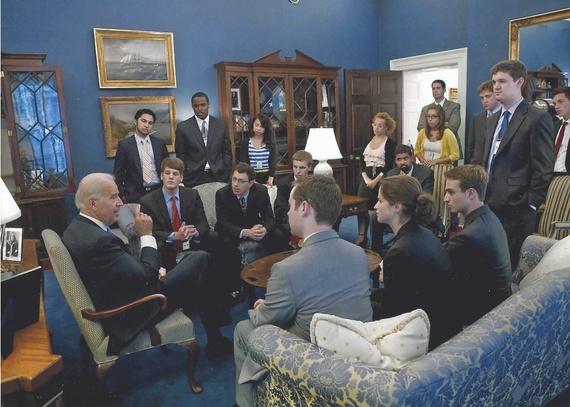I spent the summer of 2010 drafting speeches for Vice President Biden.
Like Ainsley Hayes on The West Wing, I'd wanted to work at the White House since I was about two. I wanted to be in the room, to contribute what wisdom I had, to offer my two cents in a place that leverages pennies into dollars.
But I also wanted to work there because I thought it was fucking cool. Like a lot of young people infected with the public service bug, the building itself had long been a polestar in my political imagination. For some people, it's Hollywood; for others, the boardroom. For me, it had always been the grassy expanse of the South Lawn, the big, dark cars idling on the circular drive and the quiet, contained power of the West Wing.
It was with this mix of motivations that I had applied for the White House Summer Internship Program. In addition to the usual essays and recommendations, the application asked a series of questions. One of them stood out: "What was your favorite moment during the campaign?" In other words, Have you been paying attention? And are you on board with us?
There's nothing particularly noteworthy about politicians seeking loyal staffers, of course. (I'd certainly met with more intense grilling in the past.) The work isn't neutral, and given the suspicion that pervades our political culture, perhaps there's a need to ferret out would-be spies. Still, something about the phrasing jumped off the page. This wasn't going to be like a school seminar, or even like the rolling debate club that Aaron Sorkin had created for television. I was applying to work for a group of people that already knew what they thought about all of the things that I didn't. Think of the many things you loved about our campaign, and choose your very favorite.
I was accepted to the program, and then chosen from the intern pool by the Office of the Vice President. I would be working for the VP's speechwriter, Matt Teper.
The vice president's communications team works in the Old Executive Office Building, a giant gray battleship that sits adjacent to the West Wing. Our offices were furnished like those on the Capitol, in a style I've come to think of as "government nice" -- dark, heavy wood and lots of vertically striped chairs in blue and seafoam and gold. Elegant, in its way, but the kind of thing you would never put in your own home.
The spaciousness of the place somehow communicated our impermanence. Interns were jammed into nooks and crannies, of course, but people of reasonably important rank occupied gorgeous, high-ceilinged offices painted in lovely pastels -- the kinds of rooms that probably couldn't be built in today's era of intense media scrutiny. Get comfortable while you're here, the place seemed to breathe. But know that it won't be for long.
The OEOB had been built in the 19th century for the State, Navy and War Departments, and something about the scale of the halls said so. There are nearly two miles of them, and they all go in straight, forever-long lines. When I took breaks from my little hutch and wandered around, the 20-foot ceilings would amplify my footsteps' clicks into something bigger, more durable and resounding. The halls were wide enough to house missiles -- or the conversations that would prevent their launch.
In a political culture whose religion is power, the White House is the quintessential object of worship. It is the fantasy destination of nearly every prominent politician, the building in the background of every political newscast, and a weirdly ambiguous Mecca for the crowds lining Pennsylvania Avenue. They mill about, staring: What does it mean? And why does it draw us so?
I had thought being inside would feel different. And on one level, it did -- many of the folks who had managed to find employment inside the fence seemed to have gotten used to it. There was even a bizarre normalcy to some aspects of office life there -- printers still printed, fax machines still faxed, and Ike's Cafe only offered my favorite Jell-O-with-whipped-cream desserts on special days. I felt an odd juxtaposition between the very impersonal way we talk about the White House as an institution ("Today, the White House demanded...") and the very recognizable humanity of the people who work there each day.
But I never forgot where I was, and I don't think anyone else did either. There was a constant sense of proximity, an awareness of how everyone ranked, a feeling that the organizational hierarchy was somehow etched into the atmosphere.
One example was the photos. Throughout the West Wing and the OEOB hangs a series of large, framed shots of the president, vice president and senior staff. Sometimes, these figures are accompanied by members of the public; other times, they are portrayed alone and at work. But in all of the pictures, the president and vice president are the focal points.
In what was already the world's most inward-looking building, this struck me as strange. Yes, I understood that these photos could inspire, reminding staffers that however hard they were working, they were doing so as part of a team and under the leadership of men who had made very real sacrifices.
But I also worried about what the photos conveyed. Who were we working for, exactly? Yes, of course -- the president. But in my mind, he was only a vehicle to serve our fellow citizens. Might it not have been more inspiring to look up and see an image of a struggling family in New Orleans, an LGBT activist on the march, a child bent over her studies? Did I really need to look up from the treadmill at the White House gym and see a blown-up photo of the president stretching for a layup?
Read the full essay at The Wheat and Chaff.
